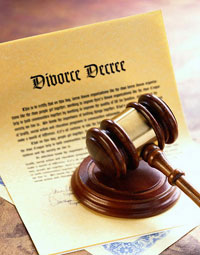Divorce proved to be harmful for environment
Divorce has been determined to be dangerous for the environment.

Divorce rates have been rising in countries around the world, and each time a family dissolves the result is two new households.
"A married household actually uses resources more efficiently than a divorced household," said Jianguo Liu, an ecologist at Michigan State University , whose analysis of the environmental impact of divorce appears in this week's online edition of Proceedings of the National Academy of Sciences.
More households mean more use of land, water and energy, three critical resources, Liu explained in a telephone interview Monday.
Households with fewer people are simply not as efficient as those with more people sharing, he said. A household uses the same amount of heat or air conditioning whether it has two or four people living there. A refrigerator uses the same power whether one person is at home or several. Two people living apart run two dishwashers, instead of one.
Liu, who researches the relationship of ecology with social sciences, said people seem surprised by his findings at first, and then consider it simple. "A lot of things become simple after the research is done," he said.
Some extra energy or water use may not sound like a big deal, but it adds up.
The United States, for example, had 16.5 million households headed by a divorced person in 2005 and just over 60 million households headed by a married person.
Per person, divorced households spent more per month for electricity compared with a married household, as multiple people can watch the same television, listen to the same radio, cook on the same stove or eat under the same lights.
That means some $6.9 billion ( EUR 4.7 billion) in extra utility costs per year, Liu calculated, plus an added $3.6 billion ( EUR 2.5 billion) for water, in addition to other costs such as land use.
And it isn't just the United States .
Liu looked at 11 other countries, including Brazil, Costa Rica, Ecuador, Greece, Mexico and South Africa , between 1998 and 2002.
In the 11, if divorced households had combined to have the same average household size as married households, there could have been a million fewer households using energy and water in those countries.
"People have been talking about how to protect the environment and combat climate change, but divorce is an overlooked factor that needs to be considered," Liu said.
Liu stressed that he is not condemning divorce: "Some people really need to get divorces." But, he said, "one way to be more environmentally friendly is to live with other people and that will reduce the impact."
Don't get smug, though, married people; savings also apply to people who live together without marriage, and hippie communes would have been even more efficient.
So, what prompts someone to figure out the environmental impact of divorce?
Liu was studying the ecology of areas with declining population and noticed that even where the total number of people was smaller, the number of households was increasing. He wondered why.
There turned out to be several reasons: divorce, demographic shifts such as people remaining single longer and the demise of multigenerational households.
"I was surprised because the divorce rate actually has been up and down for many years in some of the countries ... but we found the proportion of divorced households has increased rapidly across the globe," he said.
So he set out to measure the difference, such as in terms of energy and water, land use and construction materials and is now reporting the results for divorce.
The research was financed by the National Science Foundation, the National Institutes of Health and the Michigan Agricultural Experiment Station.
Subscribe to Pravda.Ru Telegram channel, Facebook, RSS!


